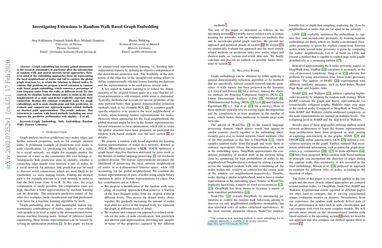Investigating Extensions to Random Walk Based Graph Embedding
Graph embedding has recently gained momentum in the research community, in particular after the introduction of random walk and neural network based approaches. However, most of the embedding approaches focus on representing the local neighborhood of nodes and fail to capture the global graph structure, i.e. to retain the relations to distant nodes. To counter that problem, we propose a novel extension to random walk based graph embedding, which removes a percentage of least frequent nodes from the walks at different levels. By this removal, we simulate farther distant nodes to reside in the close neighborhood of a node and hence explicitly represent their connection. Besides the common evaluation tasks for graph embeddings, such as node classification and link prediction, we evaluate and compare our approach against related methods on shortest path approximation. The results indicate, that extensions to random walk based methods (including our own) improve the predictive performance only slightly - if at all.
PDF Abstract


